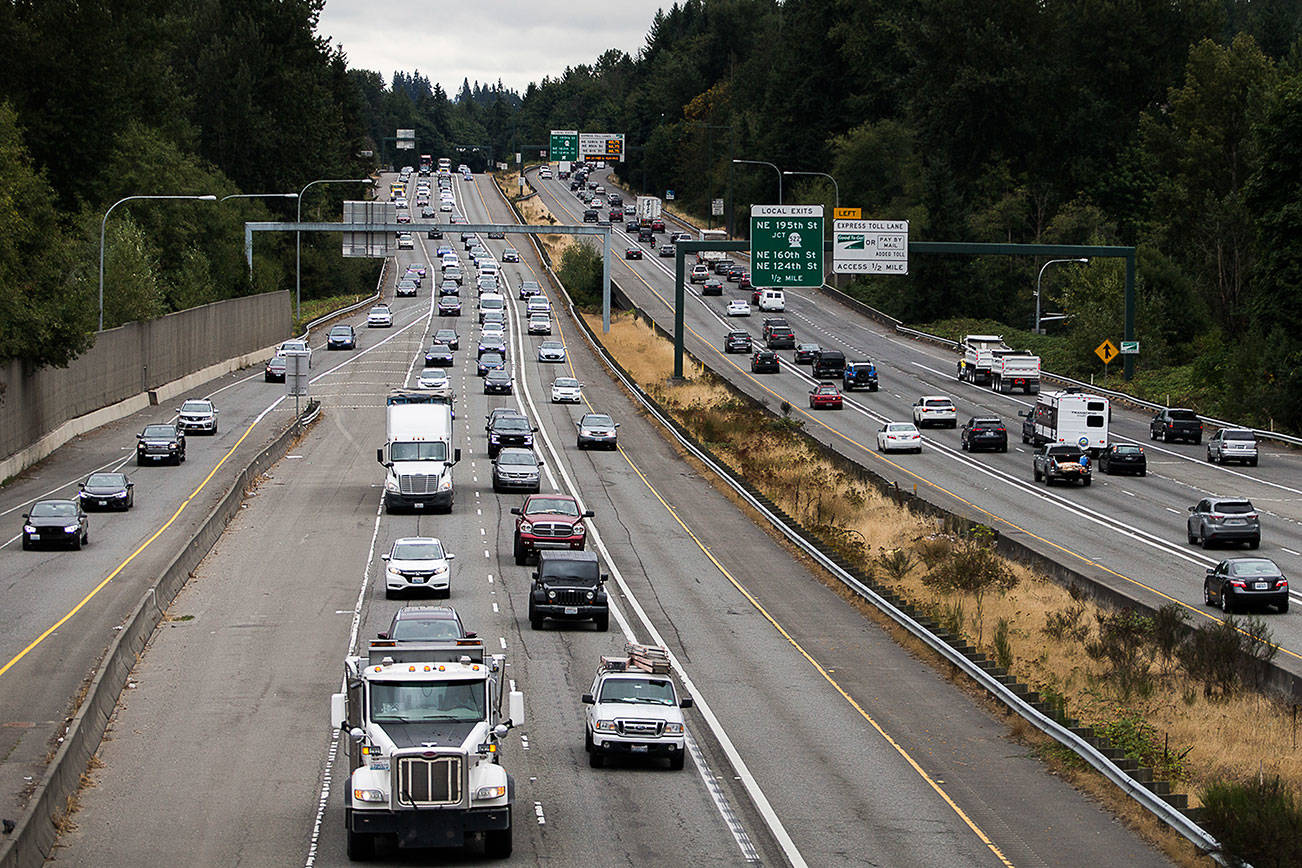The state has cleared the final environmental review to build another toll lane in each direction on I-405 between King and Snohomish counties.
At the same time, Sound Transit is sorting out changes and delays to its planned 37-mile bus rapid transit system on the freeway and eight-mile line on Highway 522.
The Federal Highway Administration issued a finding of no significant impact in July for the $600 million undertaking.
“It doesn’t mean there’s no impacts,” Washington Department of Transportation Deputy Program Administrator Rob Woeck said. “It means there’s no impact that isn’t mitigated, or is insignificant.”
The highway expansion for about 5 miles between Highway 522 to Highway 527 was supposed to open in 2025, but the pandemic and higher costs have pushed that out two years, WSDOT staff said.
Construction of the new lanes requires a mix of re-striping I-405 in one section and widening it the rest of the way, according to WSDOT documents. Two in-line transit stations would be built in the freeway median, as well as a new station at the Highway 522 interchange.
The state plans to add traffic signals at three intersections along Highway 522 at northbound I-405, southbound I-405 to eastbound Highway 522, and at new direct access ramps to the toll lanes.
Once built, the additional toll lanes will give people another option to drive outside of the general purpose lanes and enable the future Sound Transit Stride bus rapid transit to move through traffic faster. It also would build a direct access ramp from Highway 522 onto the express toll lanes and a partial direct access ramp at a rebuilt Highway 527 interchange.
Express toll lanes opened on I-405 between Bellevue and Lynnwood in 2015. Now most of the stretch has two toll lanes, but Highway 522 and north of the interchange has one.
The state’s toll lanes are free for vehicles with at least two occupants and a Good to Go transponder, except during peak hours 5 a.m. to 9 a.m. and 3 p.m. to 7 p.m. Monday through Friday. The lanes are open to all drivers after 7 p.m. weekdays, and all hours on weekends and holidays.
Since 2015, tolls have brought in over $66 million for improvements on I-405.
Toll revenue totaled $24.8 million between July 1, 2019 and June 30, 2020, according to a WSDOT financial quarterly report. That money has dropped in the current fiscal year to about $7.1 million largely because of reduced traffic during the pandemic, according to a WSDOT report.
Toll lane expansion supporters and state staff tout that it eases some congestion on a freeway stretch that state data shows averaged 106,000 vehicles a day.
“How we move more people more effectively through the system is what’s going on here,” WSDOT I-405 and Highway 167 program administrator Lisa Hodgson said.
But road expansion generally is criticized as contrary to climate action goals around reducing vehicle emissions that contribute greenhouse gases to global warming.
“It’s time for Washington state to quit highway widening cold turkey rather than continue to feed its addiction while talking a big game about getting sober around climate and road safety,” The Urbanist Editorial Board wrote in March. “… adding lanes and interchanges is clearly an expansion of highway infrastructure even if it’s dressed up with tolling or carpool lanes.”
But Hodgson and Woeck defended the I-405 expansion as compatible with the state’s climate action goals. It will improve vehicle movement with less stop-and-go traffic, boosting gas mileage and reducing some emissions, they said. Bus rapid transit also can replace some vehicle trips.
They also said toll lanes have been effective at moving traffic based on WSDOT’s study of I-5 and I-405 travel times and volumes, finding the latter faster.
“When you reduce congestion and you increase traffic speed, essentially what you get is higher gas mileage and fewer emissions,” Woeck said. “It’s really heading in the direction that our state overall and the country would like to see.”
And improved transit reliability on the expanded toll lanes could help cut vehicle trips.
Sound Transit, as part of its 2016 voter-approved tax measure, plans to bring Stride bus rapid transit to I-405 between Burien and Lynnwood and to Highway 522 between Bothell and Shoreline. The initial timeline was for service to begin in 2024, but the Sound Transit board’s realignment decisions have delayed them at least two years.
Stride’s service to Lynnwood only works with express toll lane expansion, Sound Transit east corridor development director Bernard Van De Kamp said in a system expansion committee meeting Aug. 12.
“Our (I-405) north project is highly dependent on that project going forward,” he said.
To move service closer to the original schedule, Sound Transit’s board and staff proposed scaling back and delaying elements such as parking and pedestrian bridges to some stations. That includes 300-stall parking structures in Bothell, Kenmore and Lake Forest Park to 2034. That decision is expected to defer between $150 million and $175 million in expenses.
About 10 of the 60-feet-long articulated buses serving the Stride line along Highway 522 are slated to be Sound Transit’s first battery electric coaches and the charging equipment at the planned maintenance and operations base in the Canyon Park area of Bothell.
But that facility’s costs have grown to an estimated $290 million. Making it smaller, “timely board decisions,” and improved coordination with other jurisdictions could help keep that tab from growing. Van De Kamp proposed cutting bus capacity from 120 to 80 Stride, which could save $30 million. Doing so would exclude room for Sound Transit express buses that serve Snohomish County. Construction is slated for 2025.
The Sound Transit System Expansion Committee recommended those changes to the board for consideration in the coming months.


